Articles
How might the passing of former Prime Minister Abe Shinzo impact Tokyo’s approach to Seoul? This unexpected turn of events loomed large in the minds of many who have been cautiously optimistic that Japan and South Korea would take steps toward a breakthrough in their stalled relations. In our last issue, we discussed how this summer could provide good timing for Seoul and Tokyo to create momentum in this direction after Yoon Suk Yeol’s inauguration as president in South Korea and the Upper House election in Japan. However, the results from this summer were mixed. Seoul and Tokyo have not yet announced whether Yoon and Kishida will hold a summit any time soon. Both leaders ended the summer juggling domestic politics amid declining approval ratings. However, there were some meaningful exchanges between the two governments, signaling that both sides were interested in improving relations.
Abe’s death and the Upper House election: what next?
At the shocking news of Abe’s assassination in July, major South Korean dailies denounced the act of political violence directed at a political leader during an election campaign. President Yoon made a condolence visit to the Japanese Embassy in Seoul, where he wrote, “I hope South Korea and Japan, the closest neighbors, will closely cooperate in the future.” Lee Nak-yeon, a prime minister under the Moon Jae-in government said, “we didn’t always agree with him on political and diplomatic issues. But we have cultivated a bond of personal trust.” Prime Minister Han Duk-soo and National Assembly Deputy Speaker Chung Jin-suk are to visit Japan to attend a state funeral for Abe, to be held on Sept. 27.
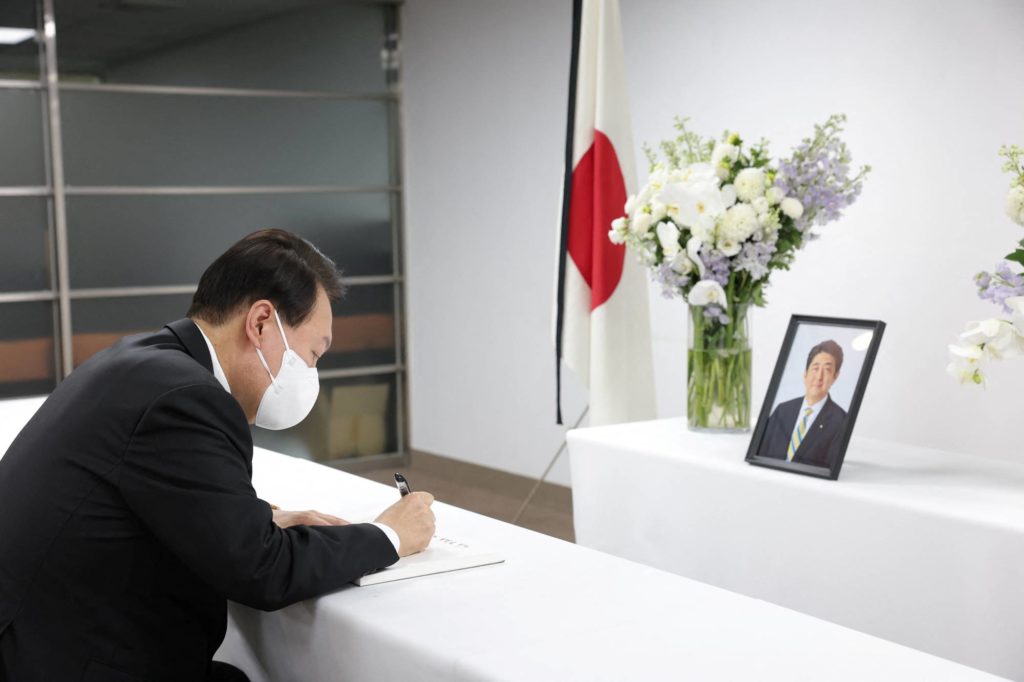
Figure 1 South Korean President Yoon Suk Yeol leaves a condolence message at a memorial altar for Japan’s late former Prime Minister Abe Shinzo at the Japanese Embassy in Seoul. Photo: Yonhap via Reuters
For most South Koreans, Abe was known for his nationalist views on historical issues at the heart of bilateral diplomatic friction. Beyond history issues, Abe’s legacy and its impact on Japan-Korea relations cannot be fully understood without considering broadly his role in shaping Japan’s direction as its longest-serving prime minister. First, he has influenced Japan’s international role, grand strategy, and national identity as a country that upholds the Peace Constitution. Japan’s postwar grand strategy—known as the Yoshida Doctrine—placed greater emphasis on developing economic over military power, while ensuring national security primarily through its alliance with the United States. Arguably, one of Abe’s legacies will be that he has led Japan away from this postwar formula. Since his first term as prime minister in 2006, Abe became a symbol of Japan’s conservative agenda and of a brand of nationalism that aspires to great power status with corresponding military capabilities. He has pursued steps toward this direction adamantly and gradually, while seeking to revise the Peace Constitution.
Whether Abe’s legacy will be constitutional revision of Article 9 weighs heavily on thinking about the future of Japan-Korea relations and is a concern in Seoul. The Liberal Democratic Party (LDP)’s revision proposals address four areas: the status of the Self-Defense Forces (SDF) (Article 9), educational system reforms, the emergency clause, and the demerging of prefectural constituencies of the Upper House. Shortly after the LDP-Komeito coalition’s victory in the Upper House election on July 10, Prime Minister Kishida Fumio vowed to “build on [Abe’s] many accomplishments,” stating that he “intends to proceed with the revision process with any one of the proposals, once approval is won after deepening discussion on them.” According to the exit poll by Jiji, the Japanese public is interested more in the economy than in constitutional revision: 30.2% of the voters responded that economic and labor policies determined their votes, while only 4.7 % said that constitutional revision was the basis of their voting decision. Among those who voted for the LDP, only 3.2 % said it was because of constitutional revision. By mid-August, a Kyodo News survey showed that only 2.1 % of Japanese respondents thought Kishida should regard constitutional revision as his top priority, while 44.9% pointed to economic measures to deal with soaring prices as the top priority.
Second, under Abe’s vision of a “rules-based international order,” Tokyo broke away from its previous reluctance toward taking a leadership role in regional affairs. In the face of a rapidly rising China and the relative decline of US power, Abe’s strategy resulted in a Japanese foreign and security policy that sought to counter China’s growing influence and assertiveness together with countries like the United States and Australia. As Abe sought to shape the international order, especially during his second term as prime minister (2012-2020), his views, and the resulting policy initiatives—simultaneously internationalist and nationalist—became more mainstream across Japan’s political spectrum. Japan’s Free and Open Indo-Pacific Strategy, the strategic focus beyond Northeast Asia on maritime areas in Southeast Asia, and the promotion of the Quadrilateral Security Dialogue (the “Quad”) and the Comprehensive and Progressive Agreement on Trans-Pacific Partnership (CPTPP) are among the significant expressions of this path. As a result, Seoul and Tokyo often found themselves adopting diverging strategies to deal with the shifting power balances in the region.
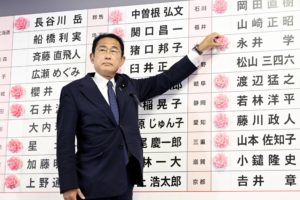
Figure 2 Japanese Prime Minister Kishida Fumio places a flower next to the name of a winning Liberal Democratic Party candidate at the party’s headquarters during the July 2022 Upper House Elections. Photo: Kyodo
Due mostly to LDP’s factional politics, it is less clear whether and when Japan will change the course of its Korea policy that Abe and his like-minded conservative colleagues have set. There was a view that the July election victory would strengthen Kishida’s position and allow him to pursue a Korea policy that restores friendly relations with the Yoon government. After the July 10 Upper House election victory, the ruling LDP-Komeito coalition increased their majority from 57% of seats to 60%. The ruling coalition also controls over 60% in the Lower House. Given that Kishida does not face Diet elections until 2025, he could have three years to pursue his own policy agenda in the absence of Abe.
However, the passing of Abe adds another layer of uncertainty and risk-aversion to Japan’s approach to Seoul. In early July, the South Korean foreign ministry launched a consultation body that brought together victims, lawyers, scholars, former government officials, and journalists in South Korea with the goal of producing a viable solution to the issue of wartime forced labor. Given the outlook of President Yoon and his team on the direction of South Korea’s foreign policy, it is likely that Seoul will continue to make efforts toward overcoming the obstacle posed by the forced labor issue. However, the Kishida government has cautiously responded to Seoul’s goodwill gestures taking minimal political risks, and is not likely to change its basic stance that South Korea should first present a solution to this issue. Abe, who could have facilitated that change in the face of opposition from conservatives skeptical about friendly relations with South Korea, is no longer able to support that agenda.
Kishida’s plan to consolidate his position within the LDP faced a setback when members of opposition parties and the public opposed his decision to hold a state funeral for Abe. Kishida made the case for the state funeral (estimated to cost $1.8 million), citing Abe’s record as prime minister. 56% of Japanese respondents answered that they were not convinced by the justification while 42.5% responded that it was sufficient. Unexpectedly Abe’s death brought to the fore links that he and other lawmakers had with the Unification Church. Despite Kishida reshuffling of the Cabinet and apologizing for some LDP lawmakers’ ties to this group, the approval rating of the Kishida government has dropped to 48.1% by early September, the lowest since he took office in October 2021. According to a Kyodo News survey, 89.5% of Japanese respondents wanted the LDP and its lawmakers to explain their links with the Unification Church more clearly, while 84.7% believed that they should sever their ties with the group. In early September, the LDP announced that 121 lawmakers had ties with the Unification Church.
Yoon’s First 100 Days
South Korean president Yoon took office on May 10 after winning the March presidential election with a razor-thin margin of 0.75%, coming into the renamed Office of the President (formerly Cheong Wa Dae) with an ambitious and expansive agenda. From the start, he had to govern with an opposition-led National Assembly. A surprise result in the June local election gave him a much-needed early political tailwind, given his lack of a clear popular mandate. However, as he passed his first 100 days in office in early August, there have been several roadblocks for the new conservative president.
First, his approval rating has plummeted to a historic low of 24% by early August, reaching the under 30% mark much faster than predecessors Moon Jae-in (near end of his five-year presidency) and Park Geun-hye (after two years). Furthermore, his agenda has been set back by a series of domestic debacles, including a poorly handled flood response in August, controversial personnel appointments and communications, soaring inflation, historic high gasoline prices, and infighting within his own People Power Party. It is no surprise that he then promised to “always attend to what the people want” during the Aug. 18 press conference marking his first 100 days.
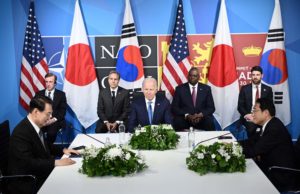
Figure 3 US President Joe Biden and members of his cabinet sit with South Korean President Yoon Suk Yeol and Japanese Prime Minister Kishida Fumio during a trilateral meeting on the sidelines of the NATO summit in Madrid on June 29, 2022. Photo: Brendan Smialowski/AFP via Getty Images
Yoon does have a relatively strong foreign policy showing so far. He set the tone for a more expansive global agenda with his first trip abroad when he attended the NATO summit in Spain at the end of May, the first-ever NATO summit invitation and appearance by a South Korean president. A very successful US-Korea summit in Seoul on May 21 preceded that trip, setting the foundations for stronger alliance cooperation for the rest of his five-year term. His administration joined the Indo-Pacific Economic Framework (IPEF), and is in discussions to join the new “Chip 4” semiconductor grouping with the US, Japan, and Taiwan.
One of the biggest indicators of South Korea’s Japan policy is Yoon’s National Liberation Day (Kwangbokchol) address on Aug. 15. This day celebrates Korea’s independence from Japan in 1945 after 35 years of Japanese colonial rule. It is a yearly tradition for the South Korean president to deliver a speech to commemorate those who fought for independence against imperial Japan. In his first Liberation Day speech, President Yoon called Japan a “partner” for South Korea to face common threats together, even as he acknowledged Korea had to “unshackled ourselves” from Japan. He appealed for the two neighbors to “swiftly” improve relations based on the spirit of the Kim-Obuchi Declaration, and to work together in areas such as economic and security cooperation. Some pundits believe that Yoon’s reconciliatory message, which had a political cost, adds credibility to his overture with Japan. On the same day, Prime Minister Kishida did not visit Yasukuni Shrine, and instead sent a ritual offering on the anniversary of Japan’s defeat in World War II. Two of his Cabinet members visited the shrine, which South Korea protested by expressing “deep disappointment and regret.”
First 100 days of Yoon-Kishida and Trilateral Cooperation
The first 100 days of the Yoon-Kishida relationship have seen many firsts, including the first trilateral leader summit and trilateral military exercise since 2017 and the first trilateral defense ministerial and South Korean foreign minister visit to Japan since 2019.
There has been a flurry of meetings geared toward strengthening trilateral cooperation between Seoul, Tokyo, and Washington. A US-Korea-Japan trilateral summit took place for the first time since 2017 on the sidelines of the NATO summit. Prime Minister Kishida, like his Korean counterpart, became the first Japanese leader to attend a NATO summit. After a protracted period of dysfunctional trilateral relations, many lauded this trilateral summit as an “important breakthrough” in diplomacy.
For the past few years, the US has played the role of facilitator, and its efforts have paid off with two new leaders in Seoul and Tokyo seemingly willing to work together. The Biden administration’s Indo-Pacific strategy, seeking a region that is “free and open, connected, prosperous, secure and resilient,” deems the cooperation and views support of its two closest allies to be vital. President Yoon understands that improving trilateral coordination can provide a stronger foundation to bolster his North Korea policy and deal with Chinese actions. It can also help his aspiration for South Korea to become a “global pivotal state.” For Prime Minister Kishida, strengthening trilateral cooperation would be helpful for the “realism diplomacy” he espoused during the Shangri-La Dialogue in June 2022. His foreign minister, Hayashi Yoshimasa, called Japan-Korea and trilateral coordination “really indispensable” for the stability of East Asia, especially for dealing with North Korea at a speech in Washington, DC on July 29. The reality remains that the three countries face common security and economic challenges, including an ever-growing North Korean threat and a more assertive and influential China.
On June 11, a trilateral defense ministerial took place for the first time since 2019 on the sidelines of the Shangri-La Dialogue in Singapore. The ministers committed to enhancing trilateral security cooperation, including in combined exercises, information sharing, and high-level policy consultations, and to identifying new trilateral actions to deal with North Korean missile tests. A day later, South Korean Defense Minister Lee Jong-sup used his Shangri-La speech to express his willingness to have a “serious dialogue” to work with Japan, despite unresolved bilateral issues. With Japanese Defense Minister Kishi Nobuo in attendance, Lee said the Yoon government wants to “normalize security cooperation” with Japan to help deal with the North Korean missile and nuclear threat.
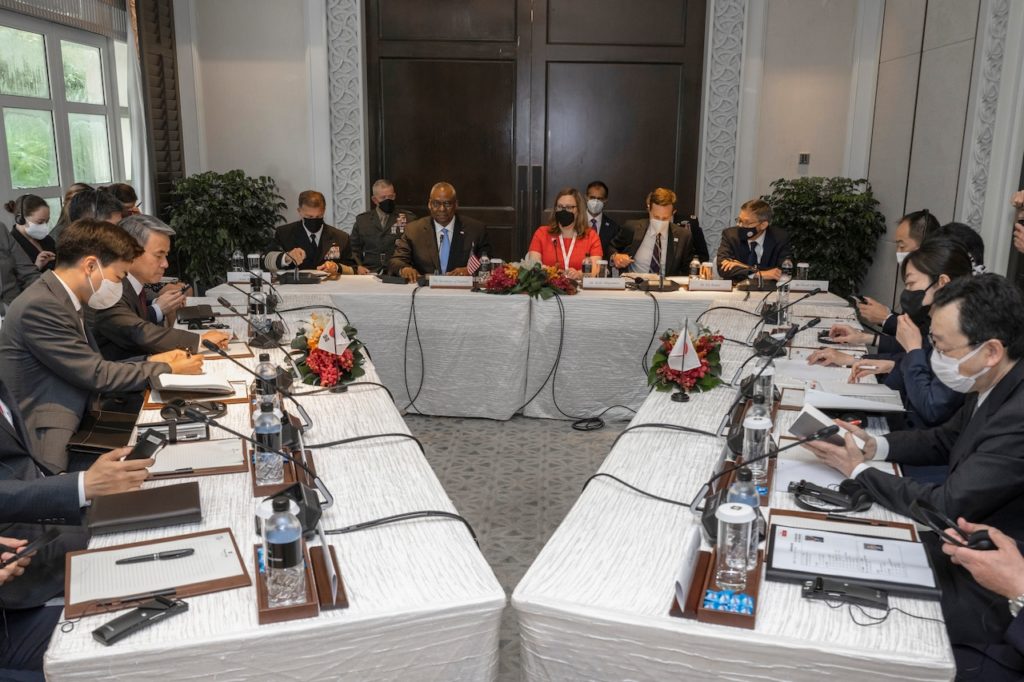
Figure 4 US Secretary of Defense Lloyd J. Austin III hosts a trilateral meeting with Japanese Defense Minister Nobuo Kishi and South Korean Minister of National Defense Lee Jong-sup at the Shangri-La Dialogue in Singapore on June 11, 2022. Photo: Chad J. McNeeley/ US Department of Defense
As widely expected, the Yoon government’s outlook on South Korean foreign policy is more open to trilateral security cooperation. Foreign Minister Park Jin spoke publicly about “normalizing” as soon as possible GSOMIA, the intelligence-sharing agreement between the Korea and Japan. Coming shortly after the assassination of Abe, Park’s visit to Japan marked the first visit by a South Korean minister to Japan since November 2019. Japanese Foreign Minister Hayashi attended Yoon’s inauguration in May. This was also their second meeting in a month, as they had met earlier on July 8 at the sidelines of the G20 meeting in Bali. During their meeting in Tokyo, the two ministers reaffirmed the importance of the bilateral relations, agreed to cooperate on the North Korean nuclear threat, and acknowledged the necessity of resolving the forced labor issue at an early date, preferably before the forced liquidation of the two Japanese companies’ assets in Korea. During the same trip, Park met with Prime Minister Kishida, and relayed Yoon’s message that he believes Kishida is “trustworthy partner” to improve bilateral relations, and that they will try to reach a “desirable solution” before the liquidation of assets. The two foreign ministers met again at the sidelines of the ASEAN summit in Phnom Penh on Aug. 4, but no breakthrough took place on the forced labor issue.
In mid-August, US-Korea-Japan followed through on the commitment made during the June defense ministerial to deepen trilateral cooperation. They conducted a trilateral missile warning and ballistic missile search and tracking exercise during the multinational Pacific Dragon exercise in Hawaii. This was the first trilateral military exercise since 2017.
Forced Labor, Comfort Women, and More
The early days have focused on incremental steps and public signaling for future cooperation, but a laundry list of unresolved bilateral issues remain. The forced labor issue remains the biggest hot button issue for the two new administrations. In anticipation of a pending final decision by the Korean Supreme Court on whether to liquidate the domestic assets of two Japanese companies (Mitsubishi Heavy Industries Inc. and Nippon Steel Corp), the Yoon government launched a government-private consultative body on July 4 to explore ways to resolve the issue with the victims. The issue topped the agenda during Foreign Minister Park’s meetings with Hayashi and Kishida in July and August. Throughout the process, Japan has maintained its consistent position that the 1965 normalization treaty settled all claims related to forced labor. A Japanese foreign ministry official warned in July that “once the assets are liquidated, there’s no going back.”
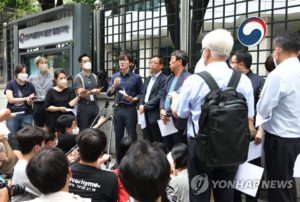
Figure 5 Legal representatives of Korean forced labor victims hold a press briefing in front of the foreign ministry building in Seoul on Aug. 9, 2022. Photo: Yonhap
The Yoon government’s efforts to improve relations with Japan came in the form of creating this consultative body. It has met four times in a closed-door setting with the goal of producing a proposal for the South Korean government. Another effort of the Yoon government was to submit an argument to the Supreme Court by the South Korean foreign ministry. The intent was to make the case for considering this issue as a matter of public interest and that it is making efforts to reach a diplomatic solution with Japan. By law in South Korea, a government agency can file an argument in a written form to present the case that concerns the public interest. The victims and their representatives roundly criticized this move. The victims’ legal representatives and most victims boycotted the third meeting on Aug. 9, which ended without a resolution. On the same day, Korea’s new ambassador to Japan, Yun Duk-min called for holding off on the liquidation process, and warned of “great damage” to Korea’s economy, including the loss of “tens or hundreds of trillions won” in business opportunities. On Aug 19, the South Korean Supreme Court delayed its final decision for further deliberation. As this body’s closed-door consultation sessions ended in early September, Park promised that he will meet with the forced labor victims to listen to their views.
On the issue of Fukushima seafood import ban, the new Yoon government maintained its position that it will not lift the ban on the grounds that the issue is of a great importance for the public health and safety in South Korea. South Korea is currently in a bid to get Japan’s support for entering the Comprehensive and Progressive Agreement for Trans-Pacific Partnership (CPTPP). However, Oceans Minister Cho Seung-hwan confirmed that South Korea will not change its position in exchange for its bid to join the CPTPP.
On the planned release of contaminated wastewater from the Fukushima Daiichi power plant, the South Korean foreign ministry participates in the International Atomic Energy Agency (IAEA)-led monitoring of the discharge plan. Japan’s Nuclear Regulation Authority approved Tokyo Electric Power (TEPCO)’s final plan on July 22 to begin discharging the wastewater next spring. The complete discharge process will likely take several decades to complete, which also involves construction of discharge facilities. The South Korean government responded to the official approval by saying it will take “best responsive measures,” while emphasizing the utmost importance of people’s health and security.
On the comfort women issue, the Yoon government has signaled its intent to respect the 2015 bilateral agreement. Park conveyed this position during his meetings with Prime Minister Kishida and LDP lawmaker Nukaga Fukushiro in Tokyo in July.
Audacious Offer to North Korea and Status Quo
President Yoon’s Liberation Day speech on Aug. 15 spelled out his audacious plan to improve North Korea’s economy in return for denuclearization. He promised a litany of economic assistance to the North, including a large-scale food program, providing assistance for power generation and distribution infrastructure, modernizing hospitals and health infrastructure, implementing investment and financial initiatives, and improving agricultural productivity. According to Kim Tae-hyo, Yoon’s deputy national security adviser, all North Korea has to do in return is correspond to the economic incentives with equal steps in a denuclearization roadmap, with the ultimate goal of “freezing, declaration, verification, and dismantlement” of its nuclear program.
North Korea responded by launching two cruise missiles two days later, its first weapons test in over two months. By the end of the week, North Korea officially responded to Yoon’s plan with a rejection from Kim Yo Jong, the powerful sister of North Korean leader Kim Jong Un. In her colorful statement, she not only called Yoon “foolish,” but also criticized his plan as “an absurd dream,” and reiterated that North Korea has no plans to denuclearize in exchange for economic incentives.
For Japan, the North Korean threat remains the important element for bilateral cooperation between Japan and Korea, and to trilateral US-Japan-Korea cooperation. This is evident by the August trilateral military exercise and numerous meetings emphasizing a common response to North Korea as a critical area of cooperation. For Prime Minister Kishida, resolution of the abductions issue remains a top priority for his administration.
Pyongyang did not mention the passing of Abe until late August. On Aug. 21, North Korean state media outlet DPRK Today referred to Abe as “a samurai descendant who committed unmeasurable crimes against Korean people,” criticizing Yoon for sending a condolence message. During the summer, there was no visible change in Pyongyang-Tokyo relations.
Looking Ahead
As summer ends, there is cause for cautious optimism. With the passing of Abe and the domestic political struggles in both Seoul and Tokyo, the state of bilateral ties prompts the question, “is the glass half empty or half full?” There has been no progress on the potential reinstatement of South Korea on Japan’s whitelist of countries with fast-track trade status, the resolution of the forced labor issue, or a summit meeting between Kishida and Yoon. Yet, South Korea is actively seeking to improve relations with Japan, while Japan is waiting for a measure on the forced labor issue that is politically acceptable domestically. In both countries, low approval ratings mean that the leaders may not have the political capital to pursue an unpopular policy at home. Without Abe, who could have persuaded conservatives skeptical of improving relations with Seoul, Kishida will now likely choose a safer political path and will not likely meet with Yoon without a deliverable on the forced labor issue in hand.
May 10, 2022: Japan’s Foreign Minister Hayashi Yoshimasa attends Yoon’s inauguration, and also meets Korean Foreign Minister Park Jin.
May 10, 2022: Yoon Suk Yeol takes office as the 20th president of the Republic of Korea.
May 12, 2022: South Korean FM Park vows to build “future-oriented partnership” with Japan during his inauguration ceremony.
May 16, 2022: Japanese government announces it will exempt travelers arriving from South Korea from quarantines if they test negative for Covid-19 upon arrival. The exemption takes effect the next day.
May 19, 2022: South Korean foreign ministry says it will participate in the IAEA-led monitoring of the planned discharge of contaminated wastewater from the Fukushima Daiichi power plant.
May 25, 2022: South Korean Minister of Oceans and Fisheries Cho Seung-hwan announces Yoon government’s intention to keep the ban on Fukushima seafood import.
May 31, 2022: Air service resumes between South Korea’s Gimhae International Airport in Busan and Japan’s Fukuoka after a two-year suspension due to the pandemic.
June 8, 2022: South Korean President Yoon announces the appointment of Yun Duk-min, the former chancellor of the Korea National Diplomatic Academy, as ambassador to Japan.
June 8, 2022: US Deputy Secretary of State Wendy Sherman, South Korean Vice Foreign Minister Cho Hyun-dong, and Japan’s Vice Minister for Foreign Affairs Mori Takeo express commitment to advance trilateral cooperation and security ties to respond to the North Korean threat during a trilateral meeting in Seoul.
June 11, 2022: US Secretary of Defense Lloyd Austin, South Korean Defense Minister Lee Jong-sup and Japanese defense Minister Kishi Nobuo hold trilateral ministerial meeting at the sidelines of the Shangri-La Dialogue in Singapore.
June 12, 2022: South Korean DM Lee expresses willingness to have a “serious dialogue” to work together with Japan during his speech at the Shangri-La Dialogue.
June 15, 2022: During a visit to the US, South Korean FM Park speaks about “normalizing” GSOMIA, the intelligence-sharing agreement between Korea and Japan.
June 29, 2022: US Sresident Joe Biden, South Korean President Yoon and Japanese Prime Minister Kishida Fumio hold a trilateral summit on the sidelines of the NATO summit in Madrid.
July 1, 2022: A support group for Korean victims of forced labor rejects a government proposal for a “subrogation payment” to resolve the forced labor issue with Japan.
July 4, 2022: Yoon government launches a government-private consultative body to look for a resolution to the forced labor issue.
July 8, 2022: Former Prime Minister of Japan Abe Shinzo is assassinated.
July 8, 2022: US Secretary of State Antony Blinken, South Korean FM Park, and Japanese Foreign Minister Hayashi Yoshimasa hold trilateral meeting at the sidelines of the G20 Foreign Ministers’ Meeting in Bali, Indonesia.
July 10, 2022: Japan holds Upper House election. The ruling LDP-Komeito coalition increase their majority from 57 % of the seats to 60 %.
July 16, 2022: Yun Duk-min, new South Korean ambassador to Japan, arrives in Tokyo to begin his posting. He is a fluent Japanese speaker, and calls the two neighbors “the most important partners that share strategic benefits” upon his arrival.
July 18, 2022: South Korean FM Park visits Japan, and meets his counterpart, FM Hayashi. This was the first visit to Japan by a South Korean foreign minister since November 2019.
July 19, 2022: South Korean FM Park meets Japanese PM Kishida in Tokyo, and relays President Yoon’s message to improve bilateral relations.
July 22, 2022: Japan’s Nuclear Regulation Authority approves Tokyo Electric Power (TEPCO)’s final plan to begin discharging the wastewater next spring.
July 26, 2022: South Korean foreign ministry files a written argument to the Supreme Court to explain its position on the forced labor issue and its efforts for a diplomatic solution with Japan.
July 29, 2022: During a visit to Washington, Japanese FM Hayashi calls Japan-Korea and trilateral coordination “really indispensable.”
July 31, 2022: A Japanese poll shows that the Kishida Cabinet’s approval rating goes down to 51%, a record low since he came to office in October 2021.
Aug. 3, 2022: Legal representatives and supporters of forced labor victims criticize the South Korean foreign ministry’s written opinion to the Supreme Court.
Aug. 4, 2022: South Korean and Japanese foreign ministers meet on sidelines of the ASEAN summit in Phnom Penh, Cambodia. A Japanese newspaper reports that South Korean side asked Japan to put Korea back on its whitelist and to remove the export controls on three chemicals.
Aug. 8-14, 2022: South Korea, Japan, and the US participate in a trilateral ballistic missile defense exercise during the broader multinational Pacific Dragon exercise in Hawaii. This was the first trilateral drill since 2017.
Aug. 9, 2022: South Korean government-private consultative body to resolve the forced labor issue meets for the third time, with boycotts by legal representatives and victims’ support group.
Aug. 9, 2022: Yun Duk-min, new South Korean ambassador to Japan, calls for holding off the liquidation process, and warns of “great damage” to the South Korean economy.
Aug. 9, 2022: South Korean Supreme Court delays making a decision on the forced labor issue case for further deliberations.
Aug. 15, 2022: South Korean President Yoon calls Japan a “partner” to face common threats together during his Liberation Day’s speech.
Aug. 15, 2022: Japanese PM Kishida sends a ritual offering, instead of visiting himself, to Yasukuni shrine for the anniversary of Japan’s defeat in World War II.
Aug. 31, 2022: South Korean FM Park announces intention to meet with forced labor victims.